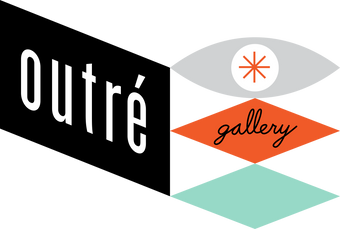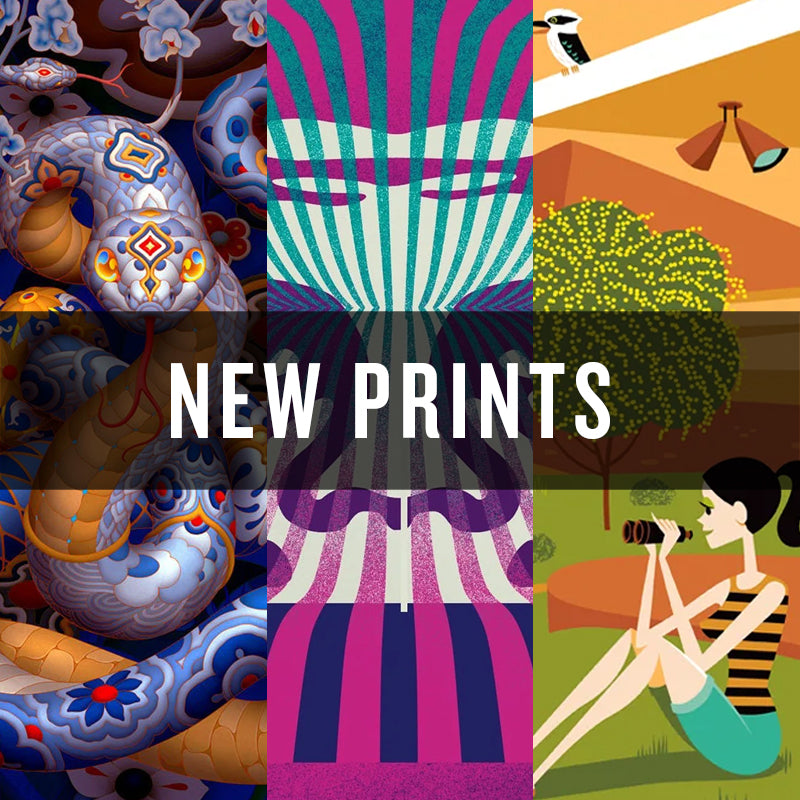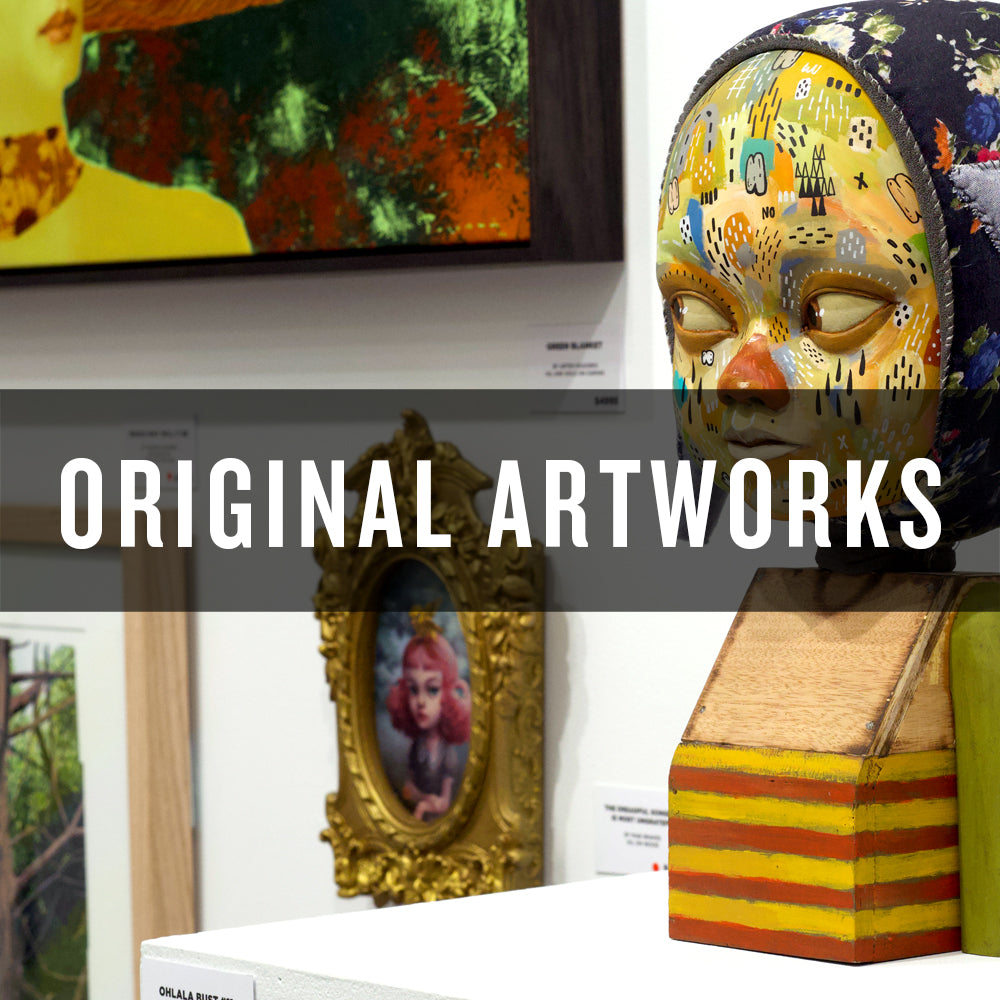
Simon Bethell, known as Simon Lice or Lice 4 Life, is a London-born artist who is now based in Melbourne. Working part-time as a jewellery maker, Simon also creates bold and graphic artworks using woodblock printing and collage. His love for tattoos and their aesthetic bleeds into his line-heavy art.
Ahead of his show Headaches Coughing Fits with Outré Gallery, we spoke to Simon about the origins of his name, his printmaking method, and his interest in the human anatomy.
Interview by Louise McIntosh. Photography by Simon Lice.
Lice is an interesting nom de plume. Tell us how this came about?
It’s not the most interesting story but I never think these things are. Pre-Instagram days I was posting my art on Facebook under my real name. I decided to open a Tumblr account – I thought it could be a nicer way of showing my art online. I wanted a title for the blog that wasn't my own name. The first name I came up with was already taken, but I was determined to set it up that day. I remembered that I had drawn the word Lice as part of a larger drawing. 'Lice for Life' just popped into my head. I thought it suited my work and sounded catchy for a blog.
Many years later the name has taken on a life of its own: it has become me and the art. It's always funny when people ask what my Instagram page is, because I tell them 'Lice4Life' and they do this weird double take like they didn’t hear me right. Haha! I guess it is quite odd and rather memorable – perfect really. In the last year I have shortened my name to Simon Lice, but Lice for Life, Lice, Licey, even good old Simon are all cool by me.

How did you get into printmaking?
I was making ink drawings and I was being asked about prints a lot. I eventually got my act together and had a small run of giclée prints made. They were well made and looked cool, but I didn’t feel like I had any connection to them. They were just copies of my artwork. It was just too clinical, it wasn’t what I was about. I needed to be hands on. After that, I gave lino printing ago. It was way more fun but they were lacking the detail that my ink drawings had, and at the time I thought I wouldn't be able to get the same detail by carving lino. I wondered whether using wood instead would hold more detail, allowing me to reproduce my drawings more closely. I did my first one and it turned out pretty good and the detail was there.
Over time I discovered that I could get the same results with lino, but for me lino doesn't feel so nice to carve. The sound that wood makes as you carve a line, the way each piece of wood feels different from the last – you even get different densities within the same block. You have to adapt every time you carve a new piece. The puzzles that printmaking throws at you and the ability to reproduce an image multiple times is what I love about it. You are always learning.
What is your favourite piece of equipment? Any backstory on its origin or sentimental value?
My Japanese 1mm U gouge tool is my favourite. I use this tool for all the small detailed lines. I bought a Swiss-made 0.5 mm U gouge tool sometime later and I thought this would be the favourite, but when I start a new block I always go back to the Japanese-made gouge first.
The day I learnt to sharpen it was a massive turning point in my practice. I went to carve a block one day and I was just chipping the wood – I wasn’t getting the clean lines like I once was. I bought some more blocks but I had the same issues. I was disheartened by this point and went back and did a couple of lino cuts which where good, but it wasn’t the same. So I decided to try to solve the issue. I eventually realised that there was nothing wrong with the wood – the gouge was blunt! I did some research on how to sharpen gouges, mixing that new knowledge with my jewellery-making skills, I managed to sharpen it for the first time and every time after that.

How does your day job influence your art practice?
I’m a jeweller by trade and the work I do is precise and detailed – very much like my woodcuts. Maybe working in that industry for so long (over twenty years) makes you this seek perfection in every aspect of your life. I’m the same when it comes to cooking a meal or whatever I do really; it has to be right and done well. It's all about the details. Only very recently I have slowly learnt to let go a little more and accept the mistakes for what they are: imperfections. Those small mistakes are what makes handmade jewellery and handmade prints so special. You can see that a person has produced them, not a computer or a machine. It doesn’t mean you don’t try as hard anymore, it just allows you sleep a little easier.
Your work is composed of an assemblage of different woodblocks to create a new image or representation. Do you envisage the final piece at first, or do you create the parts and see which fit?
Most of the time I have a rough idea of the direction I want the piece to go, but the final artwork is often quite different. There is a lot of trial and error, moving pieces about to see what fits best, jigsaw puzzle-like. All the blocks I have made, I have printed them on scrap paper. I lay these out, moving them about, adding and taking others away until I’m happy with the composition. I do the same with sketches if I haven’t made blocks yet, or if I am making one solid piece for a reduction print, or an edition piece like the ‘MANIA’ edition in the show. I will often photograph the different mock ups on my phone so I can study them over the following days and weeks. Doing this it allows me to see other details or better compositions I might have missed previously.
I believe I don’t have much say in the final piece – the images just fit where they are meant to fit. Before I get to this point I spend a lot of time standing and staring at the paper and lying on the floor, brain-fried before it all comes together.

Since the blocks are actual artworks themselves, where you can see the grooves and lines, do you display these in your studio?
I never really considered them as pieces of art in their own right. People have mention this to me before and asked whether I sell them. But I see them more as another tool, like my gouges. The gouges allow me to carve the blocks and in turn the blocks create the art. Part of the process.
I wish they were out on display. It would make my life a lot easier to find certain blocks when making the artworks. The one I’m looking for is always the last block I find. Haha. But sadly my studio is in my spare room and I draw, carve and print off one small desk. Due to the amount of blocks I have made over the last few years, I just don’t have the space to have them out on display.
Is there an attachment to certain blocks, whether it is their shape or image, as these blocks may appear in multiple final artworks?
For sure. I definitely have favourites. Not always the ones you might think pre-carving or even pre-printing. Because my work is very line heavy, there isn’t always much negative space left. After carving you can’t always see the image that well, so you don’t know if it’s going to look good once printed. The real black, heavy blocks end up being the most insane looking once printed and are often my favourites.
The way I make some of my prints by layering the different images on top of each other, you can layer the same image with multiple images and it will appear different with each one. I might carve a new block and later put it with one of the older ones, and find that the two just click. It may become one of my best artworks. It's forever evolving due to this method.
It would be a shame to have spent so much time making these blocks to limit them to one small edition. This also why I like making the one-off artworks too. It allows me to explore more possibilities and techniques. I believe this is how new ideas and growth happens.

Anatomy figures heavily in your work. Tell us more about that!
I love the different textures that you get when you start stripping back the layers of the human body. It’s so interesting! The beauty in the muscle structures, veins, fatty tissues, bones… It is so fun to draw and carve. The cross-section of a skull or head is way more interesting to me than the whole image itself, way darker. That's not to say I don’t love drawing a plain old skull. (I’ll never get bored of that – you can never have to many skulls.) Take an eyeball for example. They’re so fascinating! They become way more creepy when you take them out of context. There are just so many different layers of anatomy to explore. It never gets boring.
What was your inspiration for the body of works in this show?
The past year or so, I have been obsessed with collage and mixed media art. I think my work up to this point has been kind of collage-like in the way I overlap images and make my compositions. But I wanted to take this further and actually cut and glue sections together, but only using my own printed imagery. This allows me to make the work more complex and abstract. I want to push my work and the medium to see how far I can take it while still showcasing my print techniques. This show opportunity has inspired me to do just that with this body of work.

Has moving to Australia affected your art practice? If so, can you tell us more?
It's hard to know really. I wasn’t making either the ink drawings or the woodcuts when I arrived in Melbourne over ten years ago. I have made art in one way or another since I was kid. At school, art was the only subject I was good at. Around 11-12 years old, I got into graffiti writing and that took over my life, day and night. For one reason or another, I took a step back and only painted when the itch needed scratching. I slowly got obsessed with tattoos after that point. I guess I switched one addiction for another.
Relocating to another a country that you had never visited before is scary and exciting all at once. I felt a bit lost and disconnected early on, so I reverted back to something I knew well: graffiti. It gave me an escape from my new stressful job and a purpose to explore the new city I was living in. The first 2-3 years I was here, I went everywhere. It was a such good release.
At the same time I still had my love of tattoos. I just wasn’t getting tattooed due to cash flow and not finding an artist I wanted too work with. Eventually I started doing some stick and poke tattoos on myself. Then came the ink drawings which where inspired by tattoo flash... and here we are today.
I don't know if moving here influenced where I’m at with my current art practice, but it did ignite that creative spark back in me that I think I had lost in London. Maybe I would have found it there too, but it might have led me down a completely different path.
Thank you for your time, Simon. We are eager to see your collage prints!



